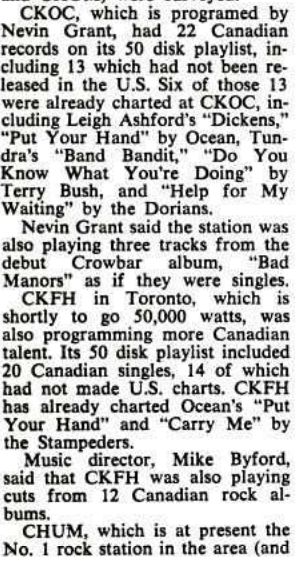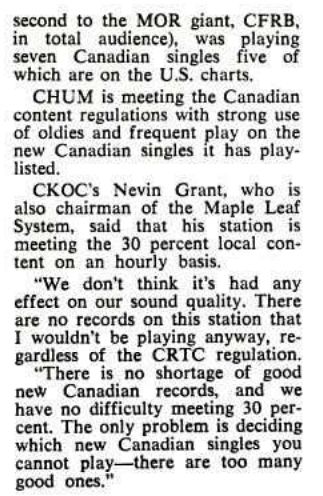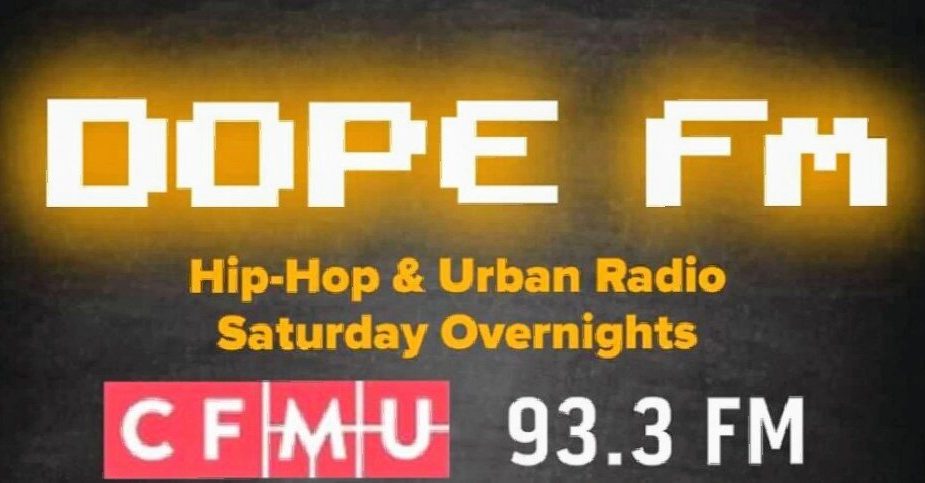- RadioActive
- Moderator
 Offline
Offline
How Did Radio Stations Here Feel About The Introduction Of CanCon?
This is from 1972, near the dawn of the Canadian Content regulations. Officials from radio stations across the country were asked for their reactions to the Canuck tunes they were playing and how they felt about them. Their answers are still illuminating, and despite the complaints about the rule, most seemed to actually like some of the records they were being forced to add to their playlists. 


- paterson1
- Member
 Offline
Offline
Re: How Did Radio Stations Here Feel About The Introduction Of CanCon?
They weren't forced to play any of these songs. What cancon they played was up to the station. Most chose these songs because they were good and fit the format... same criteria as for any other song.
This was a big reason why the regulation was brought in. Traditionally Canadian songs and artists couldn't even get airplay in their own country. Many Canadian programmers would gloss over domestic product, possibly didn't even give it a listen, and followed whatever was on Billboard.
To their credit CHUM was one of the exceptions and would play local bands from Toronto with success. However often these songs weren't picked up or occasionally not available in other parts of the country.
Cancon not only affected radio but also helped create a better national distribution system for Canadian product. Also for artists, it became a little easier to get signed by a record company, often a Canadian based label.
- RadioActive
- Moderator
 Offline
Offline
Re: How Did Radio Stations Here Feel About The Introduction Of CanCon?
According to this article, which came on the very first week CanCon rules officially went into effect - Jan. 18, 1971 - both CKOC and CKFH beat CHUM in playing records made here. In fact, it says 1050 kind of skirted the rules by loading Canadian oldies as part of their quota (in other words, previously proven performers), which wasn't exactly the intent of the law.
Of all of the local Top 40 stations around then, CKOC was always ahead of the pack, even playing CanCon well before they were supposed to. That's because then-music director, the late, great Nevin Grant, strongly believed in promoting Canadian artists regardless of the rules. 


- •
- paterson1
- Member
 Offline
Offline
Re: How Did Radio Stations Here Feel About The Introduction Of CanCon?
We also need to keep things in perspective about radio back in 1971/72. Stations often had a 3.5-5 minute newscast most hours, and were maxed out for commercials. So they were playing an average of 10-12 songs per hour, morning shows even less. The average hit song in the early 70's was also longer than hit songs today.
So on average stations would be playing 3 or 4 cancon cuts per hour total. 1 or 2 per hour could be gold and the other 1 or a 2 current hit or playlist song. So, not really that arduous a task to play 30%.
- DOPEfm
- Member
 Offline
Offline 
Re: How Did Radio Stations Here Feel About The Introduction Of CanCon?
As a current radio programmer of both community and commercial side, I can always meet Canadian content quotas.
With my community FM hip-hop overnight, I have no issues and exceed 35% CanCon.
However, with my AM commercial program with disco, I struggle to meet the same quota without overly repeating those Canadian greats within this genre. I have opened the playlist to funk and small doses of pop, rock and hip-hop that plays well with disco, and now I meet the quota.
The struggle is real, and wish the quota be reduced to 20-25% (particularly for commercial outlets)
In regards to college/community radio,the quota should remain 35% as they are locally based broadcasters
- Doug Thompson
- Member
 Offline
Offline
Re: How Did Radio Stations Here Feel About The Introduction Of CanCon?
Long before CanCon came into effect in 1971, CHUM's Program Director Allan Slaight and Music Director Bob McAdorey were playing (and charting) current Canadian artists records by Tommy Ambrose, Pat Hervey, early Gordon Lightfoot, Bobby Curtola, Richie Knight & The MidKnights (#1), The Count Victors, Leight Bell & The Chimes and that's over and above playing international Canadian artists of the day such as Paul Anka, The Diamonds and Jack Scott.
[img][IMG][/img][/img]
- RadioActive
- Moderator
 Offline
Offline
Re: How Did Radio Stations Here Feel About The Introduction Of CanCon?
I know CHUM DJ Duff Roman was a big booster of Canadian talent, since he had his own record label and was churning out a lot of stuff, including by a then relatively unknown pre-Blood Sweat and Tears lead singer named David Clayton-Thomas.
- •
- Doug Thompson
- Member
 Offline
Offline
Re: How Did Radio Stations Here Feel About The Introduction Of CanCon?
Duff produced a lot of acts, including early Levon & The Hawks, The Paupers, and of couse David Clayton-Thomas's Canadian hits. Duff took me to a little Caesar and The Consuls session at Hallmark Studios on Sackville Street in downtown Toronto in either 65 or '66. Duff certainly had a great ear. As did Stan Klees (Tamarac label) and Art Snider (Chateau Records) who recorded early Gordon Lightfoot, Pat Hervey, the Hames sister and Paul Hoffert (pre-Lighthouse).
[img][IMG][/img][/img]
 1 of 1
1 of 1